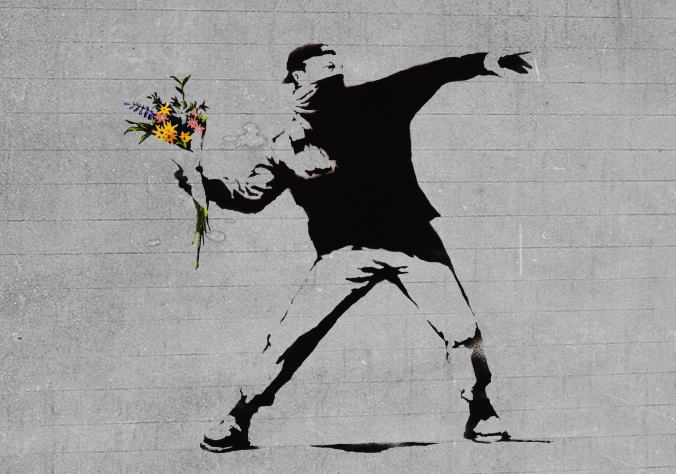This graffiti was done by the infamous Bansky. One of the worlds most renowned and anonymous artists. His works canvas the sidewalks from London to Israel and take on various political and social issues. Rage The Flower Thrower is nothing short of this. In my opinion this photograph depicts studium due to the simple fact that it reflects Banksy’s interest in political turmoil and the battle for peace. Like in the concept of studium the interpretation of this photography is subjective and dependent on the viewer’s opinion even if the does reflect a general interest of both society and the artist. As within the concept of studium also encases unary and this means that the entire meaning can be taken at a glance as demonstrated by Banskys flower thrower. This photograph captures an experience that cannot be repeated although it can be copied and certifies the presence of Bansky although he was not seen at the site of the graffiti bombing. Which are all concepts that make up stadium.
In the case of The Spinx and this photograph of it the concept behind it is one Barthes would call punctum. Punctum is a code that must deciphered by the viewer. As in the concept of punctum this photograph of The Spinx demands attention from its viewer but does not need their interpretation to give itself power for the photograph does that on its own. The punctum changes something within the observer due to the code that they uncover. The punctum of The Spinx is exactly what this photograph depicts; a partial object. A partial inference of the Egyptian empire, slavery, and wealth that is all represented by The Spinx and this photograph. The punctum can exist along the studium but more so represents a historical and an irrefutable event of the photograph. The punctum makes the photograph into a medium that can take you to another place, and lends to an alternate perception, a movement from one reality to another.
To change gears here, when it comes to Barlow and Leston’s Beyond the Blogosphere, “For The Love of Zoe” introduces its audience to concepts which our lives are consumed by but which we take little or no interest in. We live in a world that has been fighting a digital revolution according to these two authors that has changes the concept of life in how we store our experiences and how we teach these experiences. I think one of the most brilliant parts of this selection was the concept of machines having desires. ” A machine that exhibits a desire? This desire is unlike a human desire, but it is a desire nonetheless–and a significant development in human attempts to understand out machines and ourselves.” (5). I found it to be the best part of the reading and the most eye opening.
Although, humans alone exhibit the tendency of desire. When we build anything in this era of eletracy there is a desire that designers instill within each machine. When a new gadget hits the market we immediately want that machine and it is the desire that is exuded by the machine for us to want it like a obsessed teenage girl who wants Justin Bieber. These desires are not of our own but of the machine. We do not want a new jacket or necessarily need a new jacket but according to these two authors desire the jacket because the jacket desires us to want it. To relate to the digital revolution computers and laptops are not a want but a desire by eletracy for us to replace all analog forms of literacy. This desire is built in like a motherboard and is like much of eletracy is only a concept because it is an extension of the human body and mind.






Not quite sure why the Banksy is studium and the sphinx is punctum. I hear you using Barthes in the explanation, but I’m having trouble understanding why these are selected as they are.
Secondly, not quite sure I’m getting the desire part in part two. Guess I’m having a hard day!